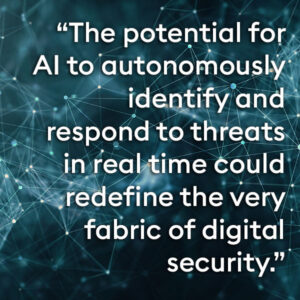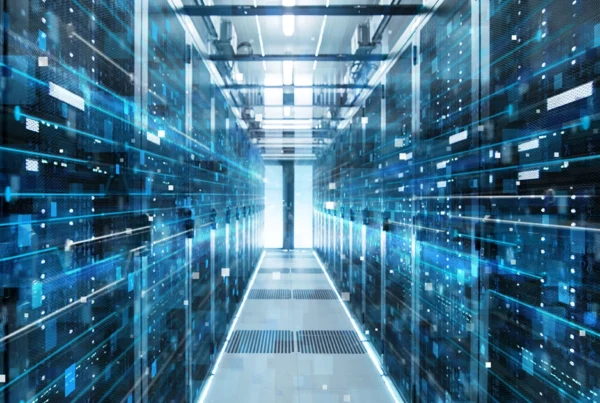AI Digital Protection and IT Security
As IT security threats grow in complexity and scale, the integration of artificial intelligence (AI) into corporate defence strategies has become a crucial part of the cat-and-mouse game between those intent on harming your business and those looking to protect it.
Few companies today can separate their prospects for success from the need for ever more sophisticated digital innovation and information security, and AI’s role in cybersecurity represents both of these things rolled into one.
This article delves into the dynamic interplay between AI and the security of your on-site and cloud computing systems, unpacking how AI-driven solutions are set to redefine our industry’s approach to digital protection, making IT systems not just reactive but also predictively secure and inherently more resilient to the threats that grow smarter each day.
The Evolution of Threat Detection
Traditional threat detection systems have served the corporate world well for many years. However, with the increased sophistication and volume of modern cyberthreats, IT security is today facing an almost overwhelming menace. Over the decades a kind of unhappy balance has been established between threat and defence, where dominance would seesaw between them, but neither would maintain the lead for long. However, that balance is being threatened and, therefore, new thinking is required.
 AI, with its unparalleled data processing capabilities, ushers in a new epoch. By analysing patterns and predicting potential breaches, AI-powered systems are transforming threat detection from a reactive to a proactive discipline, setting a new standard in digital vigilance. But, what one side can use for the good of computer security, the other can use against it, so the very real danger of an AI-powered cybersecurity threat should be yet another motivator for organisations to build their understanding of advances in this field.
AI, with its unparalleled data processing capabilities, ushers in a new epoch. By analysing patterns and predicting potential breaches, AI-powered systems are transforming threat detection from a reactive to a proactive discipline, setting a new standard in digital vigilance. But, what one side can use for the good of computer security, the other can use against it, so the very real danger of an AI-powered cybersecurity threat should be yet another motivator for organisations to build their understanding of advances in this field.
Enhanced Response Times and Rapid Threat Mitigation
In the digital realm, where threats evolve at lightning speed, response time can mean the difference between a minor incident and a catastrophic breach with far-reaching ramifications for an organisation. AI’s ability to stand as a digital sentinel, an IT security guard watching over all of a company’s systems, instantly able to identify and respond to threats, makes a significant difference in the battle against the malevolent forces pitted against your business.
AI can process and analyse vast datasets in no time flat, dramatically reducing response times and, therefore, the potential for damage. An automated incident response powered by AI not only accelerates mitigation efforts but also ensures that responses are precision-targeted, effective and learned from, to ensure that your on-site and cloud computing security evolves over time, growing ever more efficient with each breach attempt.
How AI’s Accuracy and Efficiency is Refining Cybersecurity Practices
The precision of AI in identifying and categorising threats marks a significant leap forward in the efficacy of IT security. False positives and resource-draining wild goose chases do nothing for confidence in the sector, so anything that can help from both a practical and perception perspective can only be a good thing. AI’s sophisticated algorithms ensure that system security teams can work with greater focus and efficiency, directing their efforts where they’re most needed and ensuring that every action taken is both informed and impactful. Of course, cybersecurity is not just about the technology, it’s about what that technology can do to improve the efficient use of IT security resources. Human expertise can be freed up from surveillance and detection roles, enabling them to focus instead on more complex, strategic cybersecurity initiatives.
Cybersecurity is one of those disciplines that a client would prefer never to hear about because issues brought to their attention evidence that their first line of defence has been breached. Anything that can minimise or mitigate this will be a positive step in the right direction.
Scalability and Adaptability as a Response to the Expanding Threat Landscape
 As businesses grow and digital infrastructures become ever more intricate, the importance of IT security scalability and adaptability increasingly becomes imperative. AI’s inherent flexibility allows for cybersecurity systems to scale in tandem with your business growth, adapting to and evolving through threats as they emerge. One thing we know for certain is that the ever-present spectre of those dedicated to circumventing digital security is not going away, so new threats will emerge, more resilient and sophisticated than before. But, with AI supporting cybersecurity efforts, businesses would not just be protected from current threats, but would also be best prepared for the future challenges those new threats will pose.
As businesses grow and digital infrastructures become ever more intricate, the importance of IT security scalability and adaptability increasingly becomes imperative. AI’s inherent flexibility allows for cybersecurity systems to scale in tandem with your business growth, adapting to and evolving through threats as they emerge. One thing we know for certain is that the ever-present spectre of those dedicated to circumventing digital security is not going away, so new threats will emerge, more resilient and sophisticated than before. But, with AI supporting cybersecurity efforts, businesses would not just be protected from current threats, but would also be best prepared for the future challenges those new threats will pose.
AI’s Continuous Improvement Learning Curve
One of AI’s most profound impacts on cybersecurity is its capacity to learn, evolve and improve over time. Traditional information security solutions are created in finite form, and, as threats change, your cybersecurity needs to be manually updated, and your solution refined. However, machine learning algorithms refine themselves, evolving with every interaction, becoming ever more adept at predicting and mitigating threats. This iterative improvement process ensures that cybersecurity measures are not created as static solutions but are formed to continually advance and, with hope (and some very sophisticated coding), stay one step ahead of potential threats to your organisation.
Trends and Predictions for AI-Led Cybersecurity
 Looking into the not-too-distant future, the integration of AI in cybersecurity is set to deepen, with predictive analytics, deep learning, and natural language processing becoming standard components of any organisation’s IT security arsenal. The potential for AI to autonomously identify and respond to threats in real time could redefine the very fabric of digital security. However, with great power comes great responsibility and there are ethical considerations to factor into future decision-making on this matter. Things like confidentiality and data privacy, AI bias, and the potential for AI-driven threats will themselves become important discussion points – the conclusions we come to about these matters will undoubtedly shape the future of AI in cybersecurity.
Looking into the not-too-distant future, the integration of AI in cybersecurity is set to deepen, with predictive analytics, deep learning, and natural language processing becoming standard components of any organisation’s IT security arsenal. The potential for AI to autonomously identify and respond to threats in real time could redefine the very fabric of digital security. However, with great power comes great responsibility and there are ethical considerations to factor into future decision-making on this matter. Things like confidentiality and data privacy, AI bias, and the potential for AI-driven threats will themselves become important discussion points – the conclusions we come to about these matters will undoubtedly shape the future of AI in cybersecurity.
Conclusion
The AI cat is out of the bag. Advanced learning systems may be in their early developmental phases, but just as the harnessing of nuclear fusion offered humanity both good and bad potential, so does the advancement of AI in our world. While it’s impossible for us to tell whether AI will ultimately make IT security threats a thing of the past, or seek instead to enslave humanity, one thing for sure is that there’s no going back now. AI is an element of our future and if we do not look to embrace it, understand it and utilise its power for good, then we will fall behind those who will.
The convergence of AI and cybersecurity represents a paradigm shift in how we protect our digital assets. As we navigate this new frontier, the fusion of human expertise with artificial intelligence stands as our best defence against the ever-evolving landscape of information security threats, promising the prospect of a safer, more secure digital future, or one that’s far darker.
To summarise: AI’s role in cybersecurity has the potential to be completely transformative, offering enhanced precision, efficiency, speed and adaptability. It heralds a new era where cybersecurity is not just reactive but proactive, predictive and strategic, empowering organisations to stay ahead of threats and forge a more secure path in an ever more dangerous interconnected world.
Telephone: +44 (0)20 3795 6880
Have you enjoyed this blog? If so, why not share it on your preferred social media platform?






